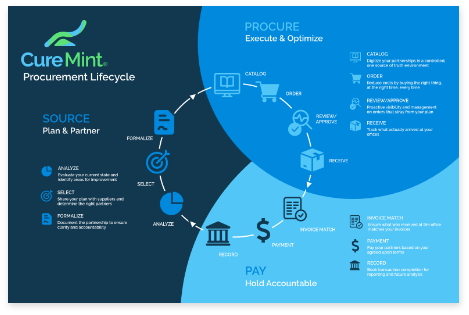For rapidly growing dental service organizations (DSOs), the idea of controlling supply spend across multiple offices in various locations probably sounds like a pipe dream. There may be hundreds (if not thousands) of purchases, supplies, and invoices coming in and out of a dental practice in any given month, leaving CFOs and finance teams overwhelmed by the sheer volume of data. Even when an organization tries to implement manual budget spreadsheets and month-end reporting at each office, these are lagging indicators that make the accounting team want to pull their hair out when one or more offices has already hemorrhaged the money away.
Meanwhile, the lofty vision of a well-oiled dental organization where spend is predicted, monitored, and accounted for, down to every last dollar, feels like an insurmountable challenge. We know that cutting costs is the easiest way to boost your dental practice’s EBITDA because $1 in savings equals up to $20 in revenue, but if you don’t know where to start, or how, you’ll be left spinning your tires while the market edges you out. Fortunately for growing DSOs, achieving dental practice spend management isn’t as unrealistic as it seems – all it takes is a readiness to start and having the right toolkit at hand.
Measuring spend across dental offices
First, you need to understand what your current spending level is. Establishing a benchmark for your spend will give you a reference point to monitor and gauge the health of your spend going forward. It doesn’t matter if you don’t get it right at first, the most important part is to consistently track all the expenses leaving your organization. Later, once you start to see the full picture of your spend, you can begin to identify areas for improvement and where to cut costs.
Gathering spend data across all your dental offices can be a hassle if your organization is relying on manual tasks and paper processing, but dental procurement software makes it easy to get a birds eye view of your spend. A dental procurement solution lets you create a standard process for purchasing, approving, receiving, and paying for dental supplies across all your offices. Every order going into the system generates a valuable string of information, from how much was spent to the product SKU, which is recorded for convenient reporting and analysis. This data forms a single source of truth across all offices in your organization where you can easily view spending patterns and activity from a central dashboard.
In order to efficiently measure where your spend is going, you’re going to want to use a procurement solution that has budget features. For example, let’s say you have 3 offices that are buying supplies at random from different suppliers. Using the default budget feature that comes with a dental procurement solution like CureMint, you could set each office’s budget for way higher than you think could ever be reasonable. (Let your offices know it’s not a “budget” per se– it’s just a way to get a general idea of what’s being spent.) Then all you have to do is sit back and watch.
As the purchases go in, your budget will fill up with a valuable trove of information that shows when, where, and how much each office is spending. Once you get a better view – after maybe a month or two – then you can start setting custom budgets for each office. The goal here is to create different buckets of spend using different rules. Maybe you want to see what is being spent on a certain specialty, or the split between general practice and front office, or how much each office is spending on bibs – whatever makes sense for your organization.
In time, once you’ve gained actionable insights from the different spending buckets, you should aim to get even more granular and tackle the spending habits and intricacies that are leading your organization to overspend. For instance, maybe you’re finding that one office is spending an awful lot on heavy body. What’s going on there? With this information in hand, backed by verifiable data, you can build a cost reduction strategy to drive down your supply costs.
Managing spend with proactive controls
Ultimately, achieving spend management starts with knowing the who, what, where, when and how of your office spending. But the actual execution of spend management – eliminating wasteful purchasing at dental offices – involves preventing rogue spending before it happens. There are many different ways to go about this:
- Formularies: A formulary is your own custom supply catalog from which your offices order supplies. Whether you belong to a group purchasing organization (GPO) or your practice has negotiated special pricing with suppliers, it doesn’t do you any good if your offices are ordering off formulary. Dental procurement software with shopping lists and catalog management features can help resolve these issues, making it easier for offices to get the supplies they need from the right source every time.
- Purchase Orders & Approvals: One of the most effective ways to reduce dental supply costs is a formal review and approval process that lowers the risk of overspending. If offices submit purchase requests for every order, then managers can review and prevent unnecessary purchases before the money is spent. A lot of organizations are afraid that approval workflows will slow down their procurement process, but through the power of automation, person-specific order rules notify the right person quickly so that office purchasers can get the answer they need promptly.
- Invoice Matching: Did you know that industry studies estimate as many as 3% of invoices are duplicates or erroneous? Automated invoice processing helps reduce the hidden costs in the invoice process for dental practices. Gone are the days of paying for fraudulent invoices: 3-way invoice matching ensures you’re only paying the correct amount by verifying each purchase order matches what was received at the office and what’s listed on the invoice – and not a dollar more.
Having a dedicated set of tools designed to prevent overspending at dental offices makes proactive spend management much more attainable for growing DSOs. And while procurement managers may not be able to avoid every costly purchase, gathering regular data points and following the top procurement KPIs for dental practices can help you determine if an office or purchaser is going off track – before it’s too late.
Rinse and repeat
As you can see, establishing a culture of spend management at your dental organization is not as daunting as it seems. In fact, some of the most gains are made from simple changes. By picking somewhere to start – budgeting, approvals, invoice matching, etc. – dental organizations can start to achieve consistency that drives real results of saving money day in and day out.
The key is to keep it simple to start. Remember, you don’t have to get it perfect at the beginning – it’s more important to be able to establish that initial benchmark, understand where you are, and then form a plan of where you’d like to be. Once you can confidently say to yourself, “We’re here … how do we get over there?” it will be much easier to identify the changes that need to be made in your organization’s procurement process and build a strategy for continued success.
Want to see CureMint’s dental spend management solution in action? Sign up today for a free demo.
Related Blogs
Dental Procurement vs. Dental Supply Purchasing: What’s the Difference?
11.02.21
As dental practice owners and office managers look into their…
Using Big Data to Lower Dental Supply Costs
09.28.21
As the dental market surpasses $150 billion and private…
Not All Dental Costs Are Equal: Which One Are You Focusing On?
09.27.21
It doesn’t matter whether you’re whitening teeth or selling…





